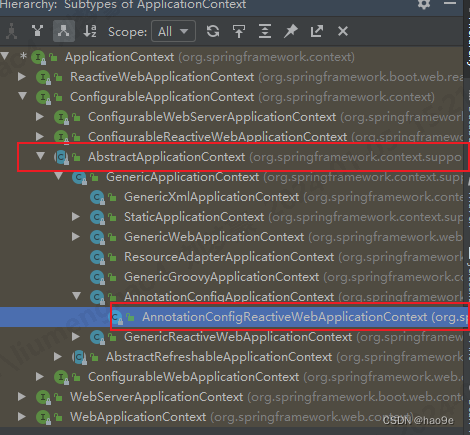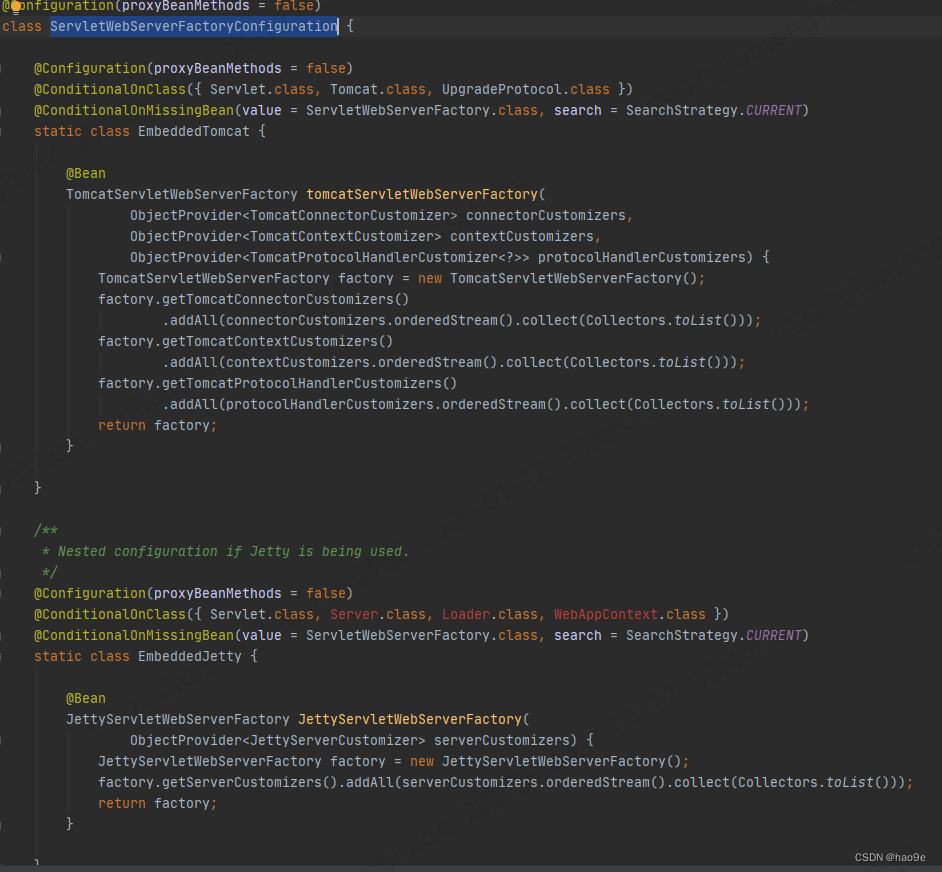本文主要是介绍SpringBoot 源码解析4:refresh 方法解析,希望对大家解决编程问题提供一定的参考价值,需要的开发者们随着小编来一起学习吧!
SpringBoot 源码解析4:refresh 方法解析
- 1. refresh 方法解析
- 2. 准备刷新 AbstractApplicationContext#prepareRefresh
- 3. 获取bean工厂 AbstractApplicationContext#obtainFreshBeanFactory
- 4. 准备bean工厂 AbstractApplicationContext#prepareBeanFactory
- 5. ServletWebServerApplicationContext#postProcessBeanFactory
- 6. 调用BeanFactoryPostProcessor AbstractApplicationContext#invokeBeanFactoryPostProcessors
- 7. BeanPostProcessor注册 AbstractApplicationContext#registerBeanPostProcessors
- 8. 国际化支持 initMessageSource
- 9. 初始化事件分发器 AbstractApplicationContext#initApplicationEventMulticaster
- 10. 创建web容器 ServletWebServerApplicationContext#onRefresh
- 11. 注册事件监听器 AbstractApplicationContext#registerListeners
- 12. Bean的实例化 AbstractApplicationContext#finishBeanFactoryInitialization
- 12.1 DefaultListableBeanFactory#finishBeanFactoryInitialization
- 12.2 DefaultListableBeanFactory#preInstantiateSingletons
- 13. 启动web容器 ServletWebServerApplicationContext#finishRefresh
1. refresh 方法解析
AbstractApplicationContext#refresh 方法为Spring最核心的方法,Bean的注册,实例化,初始化过程都是在此方法中完成的。
从SpringBoot启动流程可知,创建了ApplicationContext为AnnotationConfigServletWebServerApplicationContext,调用AbstractApplicationContext的refresh方法。

@Override
public void refresh() throws BeansException, IllegalStateException {synchronized (this.startupShutdownMonitor) {// Prepare this context for refreshing.// 容器刷新前的准备工作prepareRefresh();// Tell the subclass to refresh the internal bean factory.// 获取DefaultListableBeanFactoryConfigurableListableBeanFactory beanFactory = obtainFreshBeanFactory();// Prepare the bean factory for use in this context.// 对bean工厂准备工作,配置prepareBeanFactory(beanFactory);try {// Allows post-processing of the bean factory in context subclasses.// 配置BeanFactory,对web的支持postProcessBeanFactory(beanFactory);// Invoke factory processors registered as beans in the context.// 调用BeanFactoryPostProcessor和BeanDefinitionRegistryPostProcessorinvokeBeanFactoryPostProcessors(beanFactory);// Register bean processors that intercept bean creation.// 注册BeanPostProcessorregisterBeanPostProcessors(beanFactory);// Initialize message source for this context.// 对国际化支持initMessageSource();// Initialize event multicaster for this context.// 初始化事件发布器initApplicationEventMulticaster();// Initialize other special beans in specific context subclasses.// 创建web服务onRefresh();// Check for listener beans and register them.// 注册时间监听器registerListeners();// Instantiate all remaining (non-lazy-init) singletons.// 实例化bean核心方法finishBeanFactoryInitialization(beanFactory);// Last step: publish corresponding event.// 启动web服务,发布事件finishRefresh();}catch (BeansException ex) {if (logger.isWarnEnabled()) {logger.warn("Exception encountered during context initialization - " +"cancelling refresh attempt: " + ex);}// Destroy already created singletons to avoid dangling resources.destroyBeans();// Reset 'active' flag.cancelRefresh(ex);// Propagate exception to caller.throw ex;}finally {// Reset common introspection caches in Spring's core, since we// might not ever need metadata for singleton beans anymore...resetCommonCaches();}}
}
2. 准备刷新 AbstractApplicationContext#prepareRefresh
容器刷新前准备工作,对环境变量进行校验,初始化监听器等。
protected void prepareRefresh() {// Switch to active.this.startupDate = System.currentTimeMillis();this.closed.set(false);this.active.set(true);if (logger.isDebugEnabled()) {if (logger.isTraceEnabled()) {logger.trace("Refreshing " + this);}else {logger.debug("Refreshing " + getDisplayName());}}// Initialize any placeholder property sources in the context environment.initPropertySources();// Validate that all properties marked as required are resolvable:// see ConfigurablePropertyResolver#setRequiredPropertiesgetEnvironment().validateRequiredProperties();// Store pre-refresh ApplicationListeners...if (this.earlyApplicationListeners == null) {this.earlyApplicationListeners = new LinkedHashSet<>(this.applicationListeners);}else {// Reset local application listeners to pre-refresh state.this.applicationListeners.clear();this.applicationListeners.addAll(this.earlyApplicationListeners);}// Allow for the collection of early ApplicationEvents,// to be published once the multicaster is available...this.earlyApplicationEvents = new LinkedHashSet<>();
}
- initPropertySources方法:对Environment中的servletContextInitParams和servletConfigInitParams的propertySource初始化。
- getEnvironment().validateRequiredProperties() 校验了是否存在requiredProperties中包含的必须存在的属性,否则会抛出MissingRequiredPropertiesException,requiredProperties默认为空。
- 初始化了事件监听器ApplicationListener和事件ApplicationEvent
3. 获取bean工厂 AbstractApplicationContext#obtainFreshBeanFactory
获取beanFactory,AnnotationConfigServletWebServerApplicationContext是GenericApplicationContext的子类,在实例化的时候,创建的是DefaultListableBeanFactory。
/**
* Create a new GenericApplicationContext.* @see #registerBeanDefinition* @see #refresh*/
public GenericApplicationContext() {this.beanFactory = new DefaultListableBeanFactory();
}
4. 准备bean工厂 AbstractApplicationContext#prepareBeanFactory
protected void prepareBeanFactory(ConfigurableListableBeanFactory beanFactory) {// Tell the internal bean factory to use the context's class loader etc.beanFactory.setBeanClassLoader(getClassLoader());beanFactory.setBeanExpressionResolver(new StandardBeanExpressionResolver(beanFactory.getBeanClassLoader()));beanFactory.addPropertyEditorRegistrar(new ResourceEditorRegistrar(this, getEnvironment()));// Configure the bean factory with context callbacks.beanFactory.addBeanPostProcessor(new ApplicationContextAwareProcessor(this));beanFactory.ignoreDependencyInterface(EnvironmentAware.class);beanFactory.ignoreDependencyInterface(EmbeddedValueResolverAware.class);beanFactory.ignoreDependencyInterface(ResourceLoaderAware.class);beanFactory.ignoreDependencyInterface(ApplicationEventPublisherAware.class);beanFactory.ignoreDependencyInterface(MessageSourceAware.class);beanFactory.ignoreDependencyInterface(ApplicationContextAware.class);// BeanFactory interface not registered as resolvable type in a plain factory.// MessageSource registered (and found for autowiring) as a bean.beanFactory.registerResolvableDependency(BeanFactory.class, beanFactory);beanFactory.registerResolvableDependency(ResourceLoader.class, this);beanFactory.registerResolvableDependency(ApplicationEventPublisher.class, this);beanFactory.registerResolvableDependency(ApplicationContext.class, this);// Register early post-processor for detecting inner beans as ApplicationListeners.beanFactory.addBeanPostProcessor(new ApplicationListenerDetector(this));// Detect a LoadTimeWeaver and prepare for weaving, if found.if (beanFactory.containsBean(LOAD_TIME_WEAVER_BEAN_NAME)) {beanFactory.addBeanPostProcessor(new LoadTimeWeaverAwareProcessor(beanFactory));// Set a temporary ClassLoader for type matching.beanFactory.setTempClassLoader(new ContextTypeMatchClassLoader(beanFactory.getBeanClassLoader()));}// Register default environment beans.if (!beanFactory.containsLocalBean(ENVIRONMENT_BEAN_NAME)) {beanFactory.registerSingleton(ENVIRONMENT_BEAN_NAME, getEnvironment());}if (!beanFactory.containsLocalBean(SYSTEM_PROPERTIES_BEAN_NAME)) {beanFactory.registerSingleton(SYSTEM_PROPERTIES_BEAN_NAME, getEnvironment().getSystemProperties());}if (!beanFactory.containsLocalBean(SYSTEM_ENVIRONMENT_BEAN_NAME)) {beanFactory.registerSingleton(SYSTEM_ENVIRONMENT_BEAN_NAME, getEnvironment().getSystemEnvironment());}
}
- 为bean工厂做准备,对bean工厂进行了配置。
- 配置了ignoredDependencyInterfaces。在Spring注入的过程中,如果是ignoredDependencyInterfaces所包含的类型bean,会忽略注入。
- 配置了resolvableDependencies,key依赖类型,value依赖bean。在Spring注入的过程中,如果注入的类型为resolvableDependencies对应的key,则注入resolvableDependencies所对应的value。
- 添加了一些后置处理器BeanPostProcessor,注册了一些单例bean。
- 注册了与Environment相关的单例。
5. ServletWebServerApplicationContext#postProcessBeanFactory
protected void postProcessBeanFactory(ConfigurableListableBeanFactory beanFactory) {beanFactory.addBeanPostProcessor(new WebApplicationContextServletContextAwareProcessor(this));beanFactory.ignoreDependencyInterface(ServletContextAware.class);registerWebApplicationScopes();
}
- 注册后置处理器WebApplicationContextServletContextAwareProcessor,在bean初始化之前,对bean设置ServletContext和ServletConfig。忽略了ServletContextAware接口依赖。
- registerWebApplicationScopes注册了request、session、application作用域。
- 创建了ServletRequest、ServletResponse、HttpSession、WebRequest可依赖对象工厂。
public static void registerWebApplicationScopes(ConfigurableListableBeanFactory beanFactory,@Nullable ServletContext sc) {beanFactory.registerScope(WebApplicationContext.SCOPE_REQUEST, new RequestScope());beanFactory.registerScope(WebApplicationContext.SCOPE_SESSION, new SessionScope());if (sc != null) {ServletContextScope appScope = new ServletContextScope(sc);beanFactory.registerScope(WebApplicationContext.SCOPE_APPLICATION, appScope);// Register as ServletContext attribute, for ContextCleanupListener to detect it.sc.setAttribute(ServletContextScope.class.getName(), appScope);}beanFactory.registerResolvableDependency(ServletRequest.class, new RequestObjectFactory());beanFactory.registerResolvableDependency(ServletResponse.class, new ResponseObjectFactory());beanFactory.registerResolvableDependency(HttpSession.class, new SessionObjectFactory());beanFactory.registerResolvableDependency(WebRequest.class, new WebRequestObjectFactory());if (jsfPresent) {FacesDependencyRegistrar.registerFacesDependencies(beanFactory);}
}
6. 调用BeanFactoryPostProcessor AbstractApplicationContext#invokeBeanFactoryPostProcessors
主要逻辑委派到PostProcessorRegistrationDelegate#invokeBeanFactoryPostProcessors方法,负责执行BeanDefinitionRegistry和BeanFactoryPostProcessor。
public static void invokeBeanFactoryPostProcessors(ConfigurableListableBeanFactory beanFactory, List<BeanFactoryPostProcessor> beanFactoryPostProcessors) {// Invoke BeanDefinitionRegistryPostProcessors first, if any.//Set<String> processedBeans = new HashSet<>();// 当前beanFactory为DefaultListableBeanFactory,可以查看类结构,是属于BeanDefinitionRegistry类型的if (beanFactory instanceof BeanDefinitionRegistry) {BeanDefinitionRegistry registry = (BeanDefinitionRegistry) beanFactory;//regularPostProcessors 存放的是BeanDefinitionRegistryPostProcessor(优先),registryProcessors 存放的是BeanFactoryPostProcessor,而BeanDefinitionRegistryPostProcessor是BeanFactoryPostProcessor的子接口List<BeanFactoryPostProcessor> regularPostProcessors = new ArrayList<>();List<BeanDefinitionRegistryPostProcessor> registryProcessors = new ArrayList<>();for (BeanFactoryPostProcessor postProcessor : beanFactoryPostProcessors) {if (postProcessor instanceof BeanDefinitionRegistryPostProcessor) {BeanDefinitionRegistryPostProcessor registryProcessor =(BeanDefinitionRegistryPostProcessor) postProcessor;//先执行BeanDefinitionRegistryPostProcessor#postProcessBeanDefinitionRegistryregistryProcessor.postProcessBeanDefinitionRegistry(registry);registryProcessors.add(registryProcessor);}else {regularPostProcessors.add(postProcessor);}}// Do not initialize FactoryBeans here: We need to leave all regular beans// uninitialized to let the bean factory post-processors apply to them!// Separate between BeanDefinitionRegistryPostProcessors that implement// PriorityOrdered, Ordered, and the rest.List<BeanDefinitionRegistryPostProcessor> currentRegistryProcessors = new ArrayList<>();// First, invoke the BeanDefinitionRegistryPostProcessors that implement PriorityOrdered.//首先,按照PriorityOrdered的顺序调用Spring容器中的BeanDefinitionRegistryPostProcessorString[] postProcessorNames =beanFactory.getBeanNamesForType(BeanDefinitionRegistryPostProcessor.class, true, false);for (String ppName : postProcessorNames) {if (beanFactory.isTypeMatch(ppName, PriorityOrdered.class)) {currentRegistryProcessors.add(beanFactory.getBean(ppName, BeanDefinitionRegistryPostProcessor.class));processedBeans.add(ppName);}}sortPostProcessors(currentRegistryProcessors, beanFactory);registryProcessors.addAll(currentRegistryProcessors);invokeBeanDefinitionRegistryPostProcessors(currentRegistryProcessors, registry);currentRegistryProcessors.clear();// Next, invoke the BeanDefinitionRegistryPostProcessors that implement Ordered.//其次,按照Ordered的顺序调用Spring容器中的BeanDefinitionRegistryPostProcessorpostProcessorNames = beanFactory.getBeanNamesForType(BeanDefinitionRegistryPostProcessor.class, true, false);for (String ppName : postProcessorNames) {if (!processedBeans.contains(ppName) && beanFactory.isTypeMatch(ppName, Ordered.class)) {currentRegistryProcessors.add(beanFactory.getBean(ppName, BeanDefinitionRegistryPostProcessor.class));processedBeans.add(ppName);}}sortPostProcessors(currentRegistryProcessors, beanFactory);registryProcessors.addAll(currentRegistryProcessors);invokeBeanDefinitionRegistryPostProcessors(currentRegistryProcessors, registry);currentRegistryProcessors.clear();// Finally, invoke all other BeanDefinitionRegistryPostProcessors until no further ones appear.//最后,调用没有实现Ordered和PriorityOrdered的BeanDefinitionRegistryPostProcessor。但是SpringBoot内置了支持@Priority和@Order注解顺序比较器AnnotationAwareOrderComparatorboolean reiterate = true;while (reiterate) {reiterate = false;postProcessorNames = beanFactory.getBeanNamesForType(BeanDefinitionRegistryPostProcessor.class, true, false);for (String ppName : postProcessorNames) {if (!processedBeans.contains(ppName)) {currentRegistryProcessors.add(beanFactory.getBean(ppName, BeanDefinitionRegistryPostProcessor.class));processedBeans.add(ppName);reiterate = true;}}sortPostProcessors(currentRegistryProcessors, beanFactory);registryProcessors.addAll(currentRegistryProcessors);invokeBeanDefinitionRegistryPostProcessors(currentRegistryProcessors, registry);currentRegistryProcessors.clear();}// Now, invoke the postProcessBeanFactory callback of all processors handled so far.//最最后,在BeanDefinitionRegistryPostProcessor调用完毕之后,才会调用BeanFactoryPostProcessor。而且是先调用BeanDefinitionRegistryPostProcessor类型的BeanFactoryPostProcessor,再调用其他类型的BeanFactoryPostProcessor,这些BeanFactoryPostProcessor不是从beanFactory中获取的,而是之前流程手动添加到applicationContext中的。invokeBeanFactoryPostProcessors(registryProcessors, beanFactory);invokeBeanFactoryPostProcessors(regularPostProcessors, beanFactory);}else {// Invoke factory processors registered with the context instance.invokeBeanFactoryPostProcessors(beanFactoryPostProcessors, beanFactory);}// Do not initialize FactoryBeans here: We need to leave all regular beans// uninitialized to let the bean factory post-processors apply to them!//在这里,才会获取beanFactory中的BeanFactoryPostProcessor,下面BeanFactoryPostProcessor调用的顺序和BeanDefinitionRegistryPostProcessor调用的顺序逻辑一样的。先按照PriorityOrdered,其次Ordered,最后调用无序的String[] postProcessorNames =beanFactory.getBeanNamesForType(BeanFactoryPostProcessor.class, true, false);// Separate between BeanFactoryPostProcessors that implement PriorityOrdered,// Ordered, and the rest.List<BeanFactoryPostProcessor> priorityOrderedPostProcessors = new ArrayList<>();List<String> orderedPostProcessorNames = new ArrayList<>();List<String> nonOrderedPostProcessorNames = new ArrayList<>();for (String ppName : postProcessorNames) {if (processedBeans.contains(ppName)) {// skip - already processed in first phase above}else if (beanFactory.isTypeMatch(ppName, PriorityOrdered.class)) {priorityOrderedPostProcessors.add(beanFactory.getBean(ppName, BeanFactoryPostProcessor.class));}else if (beanFactory.isTypeMatch(ppName, Ordered.class)) {orderedPostProcessorNames.add(ppName);}else {nonOrderedPostProcessorNames.add(ppName);}}// First, invoke the BeanFactoryPostProcessors that implement PriorityOrdered.sortPostProcessors(priorityOrderedPostProcessors, beanFactory);invokeBeanFactoryPostProcessors(priorityOrderedPostProcessors, beanFactory);// Next, invoke the BeanFactoryPostProcessors that implement Ordered.List<BeanFactoryPostProcessor> orderedPostProcessors = new ArrayList<>(orderedPostProcessorNames.size());for (String postProcessorName : orderedPostProcessorNames) {orderedPostProcessors.add(beanFactory.getBean(postProcessorName, BeanFactoryPostProcessor.class));}sortPostProcessors(orderedPostProcessors, beanFactory);invokeBeanFactoryPostProcessors(orderedPostProcessors, beanFactory);// Finally, invoke all other BeanFactoryPostProcessors.List<BeanFactoryPostProcessor> nonOrderedPostProcessors = new ArrayList<>(nonOrderedPostProcessorNames.size());for (String postProcessorName : nonOrderedPostProcessorNames) {nonOrderedPostProcessors.add(beanFactory.getBean(postProcessorName, BeanFactoryPostProcessor.class));}invokeBeanFactoryPostProcessors(nonOrderedPostProcessors, beanFactory);// Clear cached merged bean definitions since the post-processors might have// modified the original metadata, e.g. replacing placeholders in values...beanFactory.clearMetadataCache();
}
- 此方法主要负责调用BeanDefinitionRegistry和BeanFactoryPostProcessor。调用顺序如下:
1.1. 先调用BeanDefinitionRegistry再调用BeanFactoryPostProcessor。
1.2. 先调用手动注册的BeanDefinitionRegistry,再调用beanFactory中的BeanDefinitionRegistry。
1.3. PriorityOrdered接口顺序 > Ordered接口顺序 > @Priority和@Order顺序 > 无序。
1.4. BeanFactoryPostProcessor调用顺序和BeanDefinitionRegistry调用一样。 - 在SpringBoot启动流程中,创建ApplicationContext中的scanner的时候,手动注册了ConfigurationClassPostProcessor,而ConfigurationClassPostProcessor是Spring注解式支持的核心。在调用ConfigurationClassPostProcessor#postProcessBeanDefinitionRegistry方法的过程中,Spring将需要注册的Bean的信息(比如:@Component注解标注的类)注册到DefaultListableBeanFactory#beanDefinitionMap,以便实例化。
- TODO 请后续请参考 ConfigurationClassPostProcessor。
- 为什么每次调用BeanDefinitionRegistryPostProcessor,都要从beanFactory中获取,而调用BeanFactoryPostProcessor只获取了一次?
4.1. 因为BeanDefinitionRegistryPostProcessor#postProcessBeanDefinitionRegistry方法的用途是注册BeanDefinition的,在调用完BeanDefinitionRegistryPostProcessor之后,又会产生新的BeanDefinition,而这些的"新的BeanDefinition"有可能是BeanDefinitionRegistryPostProcessor。
4.2. BeanFactoryPostProcessor只是修改beanDefinition的属性而已,不会产生新的BeanDefinition。
7. BeanPostProcessor注册 AbstractApplicationContext#registerBeanPostProcessors
从方法名称上就能知道,这个方法是注册BeanPostProcessor。实际上就是把存放在DefaultListableBeanFactory#beanDefinitionMap中的bean的定义信息实例化,保存到AbstractBeanFactory#beanPostProcessors。
public static void registerBeanPostProcessors(ConfigurableListableBeanFactory beanFactory, AbstractApplicationContext applicationContext) {String[] postProcessorNames = beanFactory.getBeanNamesForType(BeanPostProcessor.class, true, false);// Register BeanPostProcessorChecker that logs an info message when// a bean is created during BeanPostProcessor instantiation, i.e. when// a bean is not eligible for getting processed by all BeanPostProcessors.int beanProcessorTargetCount = beanFactory.getBeanPostProcessorCount() + 1 + postProcessorNames.length;beanFactory.addBeanPostProcessor(new BeanPostProcessorChecker(beanFactory, beanProcessorTargetCount));// Separate between BeanPostProcessors that implement PriorityOrdered,// Ordered, and the rest.List<BeanPostProcessor> priorityOrderedPostProcessors = new ArrayList<>();List<BeanPostProcessor> internalPostProcessors = new ArrayList<>();List<String> orderedPostProcessorNames = new ArrayList<>();List<String> nonOrderedPostProcessorNames = new ArrayList<>();for (String ppName : postProcessorNames) {if (beanFactory.isTypeMatch(ppName, PriorityOrdered.class)) {BeanPostProcessor pp = beanFactory.getBean(ppName, BeanPostProcessor.class);priorityOrderedPostProcessors.add(pp);if (pp instanceof MergedBeanDefinitionPostProcessor) {internalPostProcessors.add(pp);}}else if (beanFactory.isTypeMatch(ppName, Ordered.class)) {orderedPostProcessorNames.add(ppName);}else {nonOrderedPostProcessorNames.add(ppName);}}// First, register the BeanPostProcessors that implement PriorityOrdered.// 顺序1:按照PriorityOrdered排序,然后注册sortPostProcessors(priorityOrderedPostProcessors, beanFactory);registerBeanPostProcessors(beanFactory, priorityOrderedPostProcessors);// Next, register the BeanPostProcessors that implement Ordered.List<BeanPostProcessor> orderedPostProcessors = new ArrayList<>(orderedPostProcessorNames.size());for (String ppName : orderedPostProcessorNames) {BeanPostProcessor pp = beanFactory.getBean(ppName, BeanPostProcessor.class);orderedPostProcessors.add(pp);if (pp instanceof MergedBeanDefinitionPostProcessor) {internalPostProcessors.add(pp);}}// 顺序2:按照Ordered排序,然后注册sortPostProcessors(orderedPostProcessors, beanFactory);registerBeanPostProcessors(beanFactory, orderedPostProcessors);// Now, register all regular BeanPostProcessors.List<BeanPostProcessor> nonOrderedPostProcessors = new ArrayList<>(nonOrderedPostProcessorNames.size());for (String ppName : nonOrderedPostProcessorNames) {BeanPostProcessor pp = beanFactory.getBean(ppName, BeanPostProcessor.class);nonOrderedPostProcessors.add(pp);if (pp instanceof MergedBeanDefinitionPostProcessor) {internalPostProcessors.add(pp);}}//顺序3:注册无序的beanPostProcessorregisterBeanPostProcessors(beanFactory, nonOrderedPostProcessors);// Finally, re-register all internal BeanPostProcessors.//顺序4:对MergedBeanDefinitionPostProcessor排序,然后重新注册。先remove,再addsortPostProcessors(internalPostProcessors, beanFactory);registerBeanPostProcessors(beanFactory, internalPostProcessors);// Re-register post-processor for detecting inner beans as ApplicationListeners,// moving it to the end of the processor chain (for picking up proxies etc).//顺序5:注册ApplicationListenerDetectorbeanFactory.addBeanPostProcessor(new ApplicationListenerDetector(applicationContext));
}
- BeanPostProcessor的注册顺序就是后期方法回调的顺序,它的顺序和BeanFactoryPostProcessor、BeanDefinitionRegistryPostProcessor调用的顺序几乎是一样的。
- by PriorityOrdered > by Ordered > 无序 > MergedBeanDefinitionPostProcessor > ApplicationListenerDetector。
- 注册逻辑:AbstractBeanFactory#addBeanPostProcessor,先remove在add。
@Override
public void addBeanPostProcessor(BeanPostProcessor beanPostProcessor) {Assert.notNull(beanPostProcessor, "BeanPostProcessor must not be null");// Remove from old position, if anythis.beanPostProcessors.remove(beanPostProcessor);// Track whether it is instantiation/destruction awareif (beanPostProcessor instanceof InstantiationAwareBeanPostProcessor) {this.hasInstantiationAwareBeanPostProcessors = true;}if (beanPostProcessor instanceof DestructionAwareBeanPostProcessor) {this.hasDestructionAwareBeanPostProcessors = true;}// Add to end of listthis.beanPostProcessors.add(beanPostProcessor);
}
8. 国际化支持 initMessageSource
这里是对国际化的支持,后续单独再起文章
9. 初始化事件分发器 AbstractApplicationContext#initApplicationEventMulticaster
初始化事件分发器SimpleApplicationEventMulticaster,负责事件的分发。
protected void initApplicationEventMulticaster() {ConfigurableListableBeanFactory beanFactory = getBeanFactory();if (beanFactory.containsLocalBean(APPLICATION_EVENT_MULTICASTER_BEAN_NAME)) {this.applicationEventMulticaster =beanFactory.getBean(APPLICATION_EVENT_MULTICASTER_BEAN_NAME, ApplicationEventMulticaster.class);if (logger.isTraceEnabled()) {logger.trace("Using ApplicationEventMulticaster [" + this.applicationEventMulticaster + "]");}}else {this.applicationEventMulticaster = new SimpleApplicationEventMulticaster(beanFactory);beanFactory.registerSingleton(APPLICATION_EVENT_MULTICASTER_BEAN_NAME, this.applicationEventMulticaster);if (logger.isTraceEnabled()) {logger.trace("No '" + APPLICATION_EVENT_MULTICASTER_BEAN_NAME + "' bean, using " +"[" + this.applicationEventMulticaster.getClass().getSimpleName() + "]");}}
}
- 判断是否存在名称为applicationEventMulticaster的bean或者beanDenifition或者factoryBean。
- 如果存在,则返回,不存在则注册一个SimpleApplicationEventMulticaster。
- SimpleApplicationEventMulticaster负责事件的分发,参考SpringBoot 源码解析2:启动流程
- 为什么SpringBoot启动的时候已经创建了SimpleApplicationEventMulticaster,但是此时在AbstractApplicationContext#refresh还需要注册SimpleApplicationEventMulticaster?
4.1. 之前SpringBoot启动的时候,是在SpringApplication内完成的,它的ApplicationListener监听器是手动注册的,为了监听SpringBoot启动的整个过程。
4.2. 此时注册SimpleApplicationEventMulticaster是注册到BeanFactory中,给用户使用的,用户可以自定义事件和监听器处理业务。
10. 创建web容器 ServletWebServerApplicationContext#onRefresh
此方法创建了web容器,为了后续启动Servlet。通过加载的@ConditionalOnClass判断类是否加载,众所周知,SpringBoot内置了Tomcat,注册了TomcatServletWebServerFactory。
下面是Servlet容器自动配置:

private void createWebServer() {WebServer webServer = this.webServer;ServletContext servletContext = getServletContext();if (webServer == null && servletContext == null) {//获取Servlet容器工厂ServletWebServerFactory factory = getWebServerFactory();//启动tomcat,并在tomcat声明周期Start的时候回调ServletContextInitializerthis.webServer = factory.getWebServer(getSelfInitializer());}else if (servletContext != null) {try {getSelfInitializer().onStartup(servletContext);}catch (ServletException ex) {throw new ApplicationContextException("Cannot initialize servlet context", ex);}}initPropertySources();
}protected ServletWebServerFactory getWebServerFactory() {// Use bean names so that we don't consider the hierarchyString[] beanNames = getBeanFactory().getBeanNamesForType(ServletWebServerFactory.class);if (beanNames.length == 0) {throw new ApplicationContextException("Unable to start ServletWebServerApplicationContext due to missing "+ "ServletWebServerFactory bean.");}if (beanNames.length > 1) {throw new ApplicationContextException("Unable to start ServletWebServerApplicationContext due to multiple "+ "ServletWebServerFactory beans : " + StringUtils.arrayToCommaDelimitedString(beanNames));}return getBeanFactory().getBean(beanNames[0], ServletWebServerFactory.class);
}
- 从BeanFactory中获取ServletWebServerFactory,获取的是TomcatServletWebServerFactory。
- 获取Servlet容器工厂,在tomcat声明周期Start的时候回调ServletContextInitializer,返回webServer。
11. 注册事件监听器 AbstractApplicationContext#registerListeners
注册事件监听器
protected void registerListeners() {// Register statically specified listeners first.for (ApplicationListener<?> listener : getApplicationListeners()) {getApplicationEventMulticaster().addApplicationListener(listener);}// Do not initialize FactoryBeans here: We need to leave all regular beans// uninitialized to let post-processors apply to them!String[] listenerBeanNames = getBeanNamesForType(ApplicationListener.class, true, false);for (String listenerBeanName : listenerBeanNames) {getApplicationEventMulticaster().addApplicationListenerBean(listenerBeanName);}// Publish early application events now that we finally have a multicaster...Set<ApplicationEvent> earlyEventsToProcess = this.earlyApplicationEvents;this.earlyApplicationEvents = null;if (earlyEventsToProcess != null) {for (ApplicationEvent earlyEvent : earlyEventsToProcess) {getApplicationEventMulticaster().multicastEvent(earlyEvent);}}
}
- 从SpringBoot启动流程可知,在SpringApplication#prepareContext方法中,已经将SpringApplication中的事件监听器copy到了ApplicationContext中。
- 而这里先将ApplicationListener实例注册,在将Bean工厂中的属于ApplicationListener的beanName注册。
- 监听器的回调原理请参考:SpringBoot 源码解析3:事件监听器
12. Bean的实例化 AbstractApplicationContext#finishBeanFactoryInitialization
完成BeanFactory对bean的实例化,在此之前,所有的beanDefinition都已注册到DefaultListableBeanFactory#beanDefinitionMap。
12.1 DefaultListableBeanFactory#finishBeanFactoryInitialization
protected void finishBeanFactoryInitialization(ConfigurableListableBeanFactory beanFactory) {// Initialize conversion service for this context.if (beanFactory.containsBean(CONVERSION_SERVICE_BEAN_NAME) &&beanFactory.isTypeMatch(CONVERSION_SERVICE_BEAN_NAME, ConversionService.class)) {beanFactory.setConversionService(beanFactory.getBean(CONVERSION_SERVICE_BEAN_NAME, ConversionService.class));}// Register a default embedded value resolver if no bean post-processor// (such as a PropertyPlaceholderConfigurer bean) registered any before:// at this point, primarily for resolution in annotation attribute values.// 如果beanFactory没有值解析器,那么就添加一个if (!beanFactory.hasEmbeddedValueResolver()) {beanFactory.addEmbeddedValueResolver(strVal -> getEnvironment().resolvePlaceholders(strVal));}// Initialize LoadTimeWeaverAware beans early to allow for registering their transformers early.//实例化LoadTimeWeaverAware类型的beanString[] weaverAwareNames = beanFactory.getBeanNamesForType(LoadTimeWeaverAware.class, false, false);for (String weaverAwareName : weaverAwareNames) {getBean(weaverAwareName);}// Stop using the temporary ClassLoader for type matching.beanFactory.setTempClassLoader(null);// Allow for caching all bean definition metadata, not expecting further changes.// 冻结beanDinifition,不期望后期beanDinition再被修改beanFactory.freezeConfiguration();// Instantiate all remaining (non-lazy-init) singletons.// 实例化的真正逻辑beanFactory.preInstantiateSingletons();
}
此方法很简单,看注释。
12.2 DefaultListableBeanFactory#preInstantiateSingletons
@Override
public void preInstantiateSingletons() throws BeansException {if (logger.isTraceEnabled()) {logger.trace("Pre-instantiating singletons in " + this);}// Iterate over a copy to allow for init methods which in turn register new bean definitions.// While this may not be part of the regular factory bootstrap, it does otherwise work fine.List<String> beanNames = new ArrayList<>(this.beanDefinitionNames);// Trigger initialization of all non-lazy singleton beans...// 获取到所有BeanDifinition注册的beanName,遍历创建for (String beanName : beanNames) {RootBeanDefinition bd = getMergedLocalBeanDefinition(beanName);if (!bd.isAbstract() && bd.isSingleton() && !bd.isLazyInit()) {// 判断当前的bean是否为FactoryBeanif (isFactoryBean(beanName)) {// 如果是FactoryBean,那么就获取到当前的factoryBeanObject bean = getBean(FACTORY_BEAN_PREFIX + beanName);if (bean instanceof FactoryBean) {final FactoryBean<?> factory = (FactoryBean<?>) bean;boolean isEagerInit;if (System.getSecurityManager() != null && factory instanceof SmartFactoryBean) {isEagerInit = AccessController.doPrivileged((PrivilegedAction<Boolean>)((SmartFactoryBean<?>) factory)::isEagerInit,getAccessControlContext());}else {isEagerInit = (factory instanceof SmartFactoryBean &&((SmartFactoryBean<?>) factory).isEagerInit());}//如果factoryBean是SmartFactoryBean,并且是迫切加载,那么就实例化当前beanif (isEagerInit) {getBean(beanName);}}}else {//如果不是FactoryBean,那么就创建getBean(beanName);}}}// Trigger post-initialization callback for all applicable beans...// 判断单例池中的bean如果是SmartInitializingSingleton,那么就回调afterSingletonsInstantiated方法for (String beanName : beanNames) {Object singletonInstance = getSingleton(beanName);if (singletonInstance instanceof SmartInitializingSingleton) {final SmartInitializingSingleton smartSingleton = (SmartInitializingSingleton) singletonInstance;if (System.getSecurityManager() != null) {AccessController.doPrivileged((PrivilegedAction<Object>) () -> {smartSingleton.afterSingletonsInstantiated();return null;}, getAccessControlContext());}else {smartSingleton.afterSingletonsInstantiated();}}}
}
- 判断当前的bean是否属于FactoryBean类型,如果不是FactoryBean类型,那么就直接去创建当前bean。如果不是FactoryBean,并且为SmartFactoryBean,判断是否要迫切加载。
- 判断单例池中的bean如果是SmartInitializingSingleton,那么就回调afterSingletonsInstantiated方法。
13. 启动web容器 ServletWebServerApplicationContext#finishRefresh
@Override
protected void finishRefresh() {super.finishRefresh();WebServer webServer = startWebServer();if (webServer != null) {publishEvent(new ServletWebServerInitializedEvent(webServer, this));}
}
启动web容器,发布ServletWebServerInitializedEvent事件
这篇关于SpringBoot 源码解析4:refresh 方法解析的文章就介绍到这儿,希望我们推荐的文章对编程师们有所帮助!




